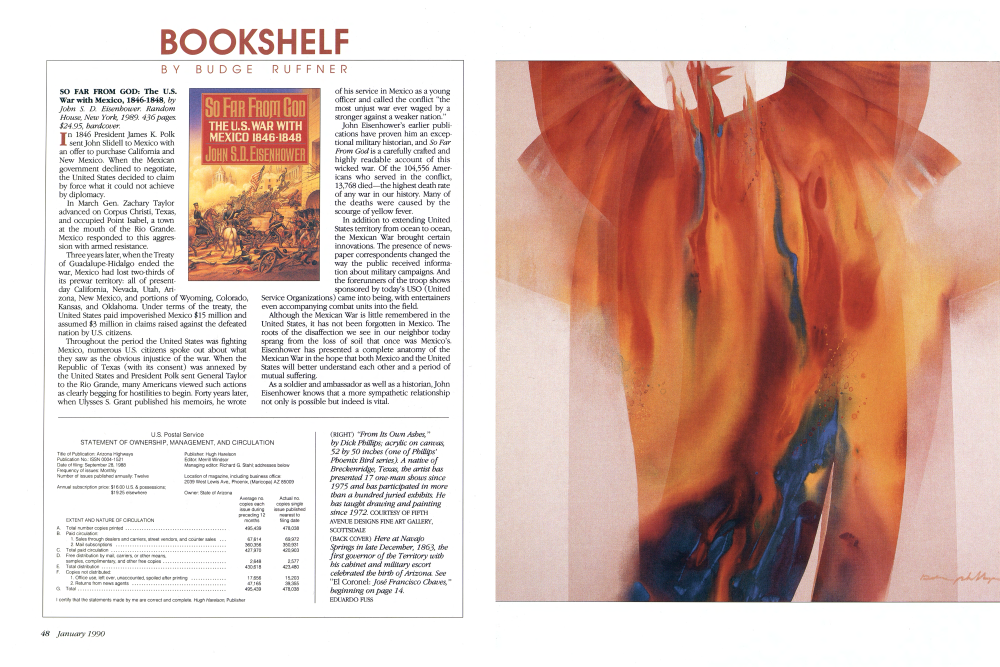Bookshelf

BOOKSHELF BY BUDGE RUFFNER
SO FAR FROM GOD: The U.S. War with Mexico, 1846-1848, by John S. D. Eisenhower. Random House, New York, 1989. 436 pages. $24.95, hardcover.
In 1846 President James K. Polk sent John Slidell to Mexico with an offer to purchase California and New Mexico. When the Mexican government declined to negotiate, the United States decided to claim by force what it could not achieve by diplomacy. In March Gen. Zachary Taylor advanced on Corpus Christi, Texas, and occupied Point Isabel, a town at the mouth of the Rio Grande. Mexico responded to this aggression with armed resistance. Three years later, when the Treaty of Guadalupe-Hidalgo ended the war, Mexico had lost two-thirds of its prewar territory: all of present-day California, Nevada, Utah, Arizona, New Mexico, and portions of Wyoming, Colorado, Kansas, and Oklahoma. Under terms of the treaty, the United States paid impoverished Mexico $15 million and assumed $3 million in claims raised against the defeated nation by U.S. citizens. Throughout the period the United States was fighting Mexico, numerous U.S. citizens spoke out about what they saw as the obvious injustice of the war. When the Republic of Texas (with its consent) was annexed by the United States and President Polk sent General Taylor to the Rio Grande, many Americans viewed such actions as clearly begging for hostilities to begin. Forty years later, when Ulysses S. Grant published his memoirs, he wrote of his service in Mexico as a young officer and called the conflict "the most unjust war ever waged by a stronger against a weaker nation." John Eisenhower's earlier publications have proven him an exceptional military historian, and So Far From God is a carefully crafted and highly readable account of this wicked war. Of the 104,556 Americans who served in the conflict, 13,768 died-the highest death rate of any war in our history. Many of the deaths were caused by the scourge of yellow fever. In addition to extending United States territory from ocean to ocean, the Mexican War brought certain innovations. The presence of newspaper correspondents changed the way the public received information about military campaigns. And the forerunners of the troop shows sponsored by today's USO (United Service Organizations) came into being, with entertainers even accompanying combat units into the field. Although the Mexican War is little remembered in the United States, it has not been forgotten in Mexico. The roots of the disaffection we see in our neighbor today sprang from the loss of soil that once was Mexico's. Eisenhower has presented a complete anatomy of the Mexican War in the hope that both Mexico and the United States will better understand each other and a period of mutual suffering. As a soldier and ambassador as well as a historian, John Eisenhower knows that a more sympathetic relationship not only is possible but indeed is vital.
of his service in Mexico as a young officer and called the conflict "the most unjust war ever waged by a stronger against a weaker nation." John Eisenhower's earlier publi-cations have proven him an excер-tional military historian, and So Far From God is a carefully crafted and highly readable account of this wicked war. Of the 104,556 Amer-icans who served in the conflict, 13,768 died-the highest death rate of any war in our history. Many of the deaths were caused by the scourge of yellow fever. In addition to extending United States territory from ocean to ocean, the Mexican War brought certain innovations. The presence of news-paper correspondents changed the way the public received informa-tion about military campaigns. And the forerunners of the troop shows sponsored by today's USO (United Service Organizations) came into being, with entertainers even accompanying combat units into the field. Although the Mexican War is little remembered in the United States, it has not been forgotten in Mexico. The roots of the disaffection we see in our neighbor today sprang from the loss of soil that once was Mexico's. Eisenhower has presented a complete anatomy of the Mexican War in the hope that both Mexico and the United States will better understand each other and a period of mutual suffering. As a soldier and ambassador as well as a historian, John Eisenhower knows that a more sympathetic relationship not only is possible but indeed is vital.
U.S. Postal Service STATEMENT OF OWNERSHIP, MANAGEMENT, AND CIRCULATION
Title of Publication: Arizona Highways Publication No.: ISSN 0004-1521 Date of filing: September 28, 1988 Frequency of issues: Monthly Number of issues published annually: Twelve Publisher: Hugh Harelson Editor: Merrill Windsor Managing editor: Richard G. Stahl; addresses below Annual subscription price: $16.00 U.S. & possessions; $19.25 elsewhere Location of magazine, including business office: 2039 West Lewis Ave., Phoenix, (Maricopa) AZ 85009 Owner: State of Arizona
I certify that the statements made by me are correct and complete. Hugh Harelson, Publisher (RIGHT) "From Its Own Ashes," by Dick Phillips; acrylic on canvas, 52 by 50 inches (one of Phillips' Phoenix Bird series). A native of Breckenridge, Texas, the artist has presented 17 one-man shows since 1975 and has participated in more than a hundred juried exhibits. He has taught drawing and painting since 1972. COURTESY OF FIFTH AVENUE DESIGNS FINE ART GALLERY, SCOTTSDALE
EDUARDO FUSS
Already a member? Login ».